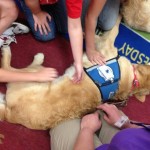Acacia Comer and Pet Partner Bonnie
Meet Alyce Sumitra and Pet Partner Max!
Therapy Dog helps calm dentists’ patients
 Molly’s contributions to the field of dentistry are often acknowledged with a smile and a pat on the head.
Molly’s contributions to the field of dentistry are often acknowledged with a smile and a pat on the head.
On most days, the 4-year-old cocker spaniel roams Applewood Family Dental in Woodbury, MN waiting to be summoned to comfort a fidgety patient.
Some people are so averse to dental work that they regularly skip cleanings or push back appointments, Dr. Brian Kraby said. To help address the problem, he decided to bring in Molly to help ease patients’ minds as they sat in his chair.
Therapy dogs long have taken part in similar programs to counter anxiety and depression in schools, libraries, hospitals and nursing homes. But Kraby said he believes Applewood is the first dental office in the state to adopt the practice.
“If that’s going to help other people for probably more traumatic situations in life, why can’t a dental office do it?” he said.
“A lot of times in dental schools you’re trained to do something just a certain way. You’re never really trained to think outside of the box.”
Kraby said he was initially skeptical when Mary Reck, his dental assistant and Molly’s trainer, came to him with the idea shortly after he bought the office in April. It only took a few appointments to change his mind.
“I’m trying to reach out to that segment of the population that won’t see a dentist, wouldn’t consider doing just routine stuff to keep the preventive aspect of things under control,” Kraby said.
On a recent morning, 10-year-old Hugh Witzmann patted Molly’s black fur with one hand while gripping the armrest with the other. The work he needed done took no more than 20 minutes, and Hugh appeared visibly relieved when it was done.
He said he was comforted by Molly’s presence. “It kind of doesn’t freak you out as much.”
Molly, who also has worked at battered women’s shelters and with children of alcoholics, had a lot of training before she was allowed to interact with patients.
She and Reck completed four obedience classes and an eight-week class at AllBreed Obedience, a dog-training school in Woodbury that partners with Pet Partners, a national nonprofit organization that brings therapy dogs to the sick and elderly.
Therapy dogs must be “comfortable in their own skin. They’re comfortable around people,” All Breed owner Debra Schneider said Monday. “These are dogs that from the get-go enjoy being around humans and have absolutely no signs of being reactive” to outside stimuli, including loud noises and other dogs.
Hypoallergenic breeds make for good therapy dogs, but Reck said that the animals — Molly included — are wiped down with disinfectant after every visit.
Dr. Edward Creagan, an oncologist at the Mayo Clinic, noted several benefits of partnering animals with patients in a video interview on Pet Partners’ website.
“When you look into the eyes of that cat, when you stroke that dog, when you hold that animal there is a surge of hormones deep within the center of the brain and these hormones provide a tremendous feeling of peace, of serenity, of tranquility. They decrease our blood pressure, they decrease our pulse, they lessen our depression,” Creagan said.
Therapy Dog Fletcher
Therapy Dogs – Born or Made
 Here is a terrific article from Patricia McConnell, the trainer and author of “The Other End of the Leash”. This is a must read for everyone who wants to understand animal behavior, which is the first step to learning how to train your dog.
Here is a terrific article from Patricia McConnell, the trainer and author of “The Other End of the Leash”. This is a must read for everyone who wants to understand animal behavior, which is the first step to learning how to train your dog.
Retiring therapy dog “graduates” alongside students
 Prince, a 9-year-old golden retriever, is retiring after nearly five years of helping students at Portage High School in Illinois, and the occasion is being marked in traditional high school fashion. Prince’s photo was included in the annual yearbook, and he’ll join graduates in this weekend’s ceremony sporting a custom cap and gown. Bred by Lutheran Church Charities, Prince lives with his handler, school guidance counselor Tim Kunstek. “It’s pretty phenomenal how much the kids love him,” said Kunstek. Yahoo/Shine (6/6)
Prince, a 9-year-old golden retriever, is retiring after nearly five years of helping students at Portage High School in Illinois, and the occasion is being marked in traditional high school fashion. Prince’s photo was included in the annual yearbook, and he’ll join graduates in this weekend’s ceremony sporting a custom cap and gown. Bred by Lutheran Church Charities, Prince lives with his handler, school guidance counselor Tim Kunstek. “It’s pretty phenomenal how much the kids love him,” said Kunstek. Yahoo/Shine (6/6)
One very furry high school graduate was honored this week with a yearbook photo of his own.
Prince “the therapy dog,” bred by Lutheran Church Charities is a 9-year-old golden retriever who works in the guidance office at Portage High School in Indiana. He’s retiring and as a parting gift, he had a professional photo taken and published alongside the class of 2013.
“We’ve never done anything like this but it was a nice way to say goodbye to Prince,” Melissa Deavers-Lowie, Portage High School’s yearbook adviser, told Yahoo! Shine. “Parents and students thought it was so cute and funny. And on Sunday, he’ll lead the graduating class of 2013 onto the football field for the ceremony.” Naturally, he’ll be dressed for the part, wearing a custom-made red cap and gown.
“Prince comes to school and works with me in therapy groups,” Tim Kunstek, Portage High School’s guidance counselor and Prince’s handler, told Yahoo! Shine. “It’s pretty phenomenal how much the kids love him.”
Prince, who lives with Kunstek and his family in Portage, has worked a 9-5 gig for the past 4.5 years. Every day, he rides to school with Kunstek and spends his morning greeting students as they arrive at school. He also sits in on counseling sessions with Kunstek and his students, and patrols the hallways, making sure kids are going to class. During lunch, he hangs out in the cafeteria. “Kids would sit on the floor and feed him Tater Tots and other treats, but he started gaining weight, so we’ve scaled back on that,” said Kunstek. And Prince travels for work: In the wake of the tragic shootings in December at Sandy Hook Elementary School, he was on hand to ensure the children had a smoother transition back to school. “The kids at Sandy Hook loved him and all the other therapy dogs so much that Lutheran Church Charities is now trying to raise money for therapy dogs at Sandy Hook,” said Kunstek.
At the end of a long day, Prince heads home with Kunstek for dinner. Upon his retirement, he’ll remain with Kunstek and work part-time, possibly with kids. And he won’t be forgotten: His Facebook page boasts more than 1,500 likes and he keeps his friends updated with photos of his life at school and at home.
But Portage High School won’t be without a therapy dog for long. Isaiah, a 1-year-old golden retriever, is in training to be Prince’s replacement. “There’s something really calming about golden retrievers; they have a big effect on people,” said Kunstek.
Research explores the ways dogs help people heal
 In findings that support what many animal owners already know, Washington State University researchers conclude that spending time with dogs is good for people. So good, in fact, that canine companions can help address mental health disorders among humans. The study looked at teens in residential treatment centers for substance abuse. The participants’ mood and attentiveness improved after spending time with dogs, and symptoms of depression, attention-deficit/hyperactivity disorder and post-traumatic stress disorder dropped dramatically. Researcher Lindsay Ellsworth said canine companionship may stimulate the release of opioids. Discovery (6/7)
In findings that support what many animal owners already know, Washington State University researchers conclude that spending time with dogs is good for people. So good, in fact, that canine companions can help address mental health disorders among humans. The study looked at teens in residential treatment centers for substance abuse. The participants’ mood and attentiveness improved after spending time with dogs, and symptoms of depression, attention-deficit/hyperactivity disorder and post-traumatic stress disorder dropped dramatically. Researcher Lindsay Ellsworth said canine companionship may stimulate the release of opioids. Discovery (6/7)
Dogs may help to correct certain human mental health disorders by beneficially affecting brain chemistry and function, a new study suggests.
The research shows how interacting with dogs improves mood among teenagers living in residential treatment centers. In this case, the teens were in therapy for drug or alcohol abuse.
“We suggest that the dog interaction activities and/or the dog itself could potentially serve as a non-drug stimulus that may heighten the adolescents’ response to naturally occurring stimuli therefore potentially helping to restore the brain’s normal process,” said Lindsay Ellsworth, who led the research.
Ellsworth, a doctoral candidate at Washington State University, brought dogs from the Spokane Humane Society to the Excelsior Youth Center, also in Spokane. Teen participants were all males.
During daily recreation time at Excelsior, some of the teens played pool, video games or basketball. Another group interacted with the dogs, by brushing, feeding and playing with them. Before and after the activities, the teens filled an assessment used to scale and study emotion.
Ellsworth suspects that social companionship with dogs may stimulate the release of opioids, psychoactive chemicals that can relieve pain and promote pleasurable feelings. Certain drugs — legal and illegal — bind to opioid receptors in the brain, but the doggy-produced high is natural with no side effects.
Repeated drug use can significantly alter opioid systems, leaving the person feeling lonely or depressed. Social companionship with dogs appears to help alleviate these negative states.
“The relationship between humans and dogs has been in existence for thousands of years,” Ellsworth explained. “They actively seek out their owner’s attention and, from the human perception, they provide displays of affection.
She described how one teen at the center with behavioral problems benefited from the animals.
“During his first couple of encounters with the dogs, he had to learn how to control his behavior in order not to startle the dogs,” she said, adding that “his tone and voice eventually became quieter, his stroke softer, his moves more calculated versus spontaneous, and he appeared to become more aware of himself and how he was acting.”
After sessions with the dogs, his interactions with staff improved, becoming “positive and productive.”
“It could be a really novel, cost-effective and beneficial complement to traditional treatments,” said animal behaviorist Ruth Newberry about using dogs to help treat substance abuse. “This could be a win-win innovation for everyone involved, including the dogs.”
Jaak Panksepp, chair of Animal Well-Being Science at WSU, added, “This is wonderful research, and highlights how companion animals can promote therapy with teenagers who have emotional problems.”
Ellsworth suspects that dogs similarly benefit the mental health of adults, children and seniors too. Interaction with cats likely also stimulates opioid release, particularly for people who are already feline fanciers.
AHF Caring Creatures Pet Partner Teams
Therapy animals can be the best medicine
Therapy dogs have been shown to decrease cortisol levels in children with autism and ameliorate pain in chronic pain patients, according to this report. The video features the story of how a therapy dog helps one war veteran cope with severe pain and physical therapy after debilitating injuries incurred when he stepped on an explosive device. WFTV-TV (Orlando, Fla.)
BACKGROUND: Pet therapy is a broad term that includes animal-assisted therapy and other animal-assisted activities. Animal-assisted therapy is a growing field that uses dogs or other animals to help people recover from or better cope with health problems, such as heart disease, cancer and mental health disorders. (SOURCE: www.mayoclinic.com/health/pet-therapy)
WHAT IS ANIMAL ASSISTED THERAPY?: Animal assisted therapy (AAT) uses trained animals to enhance an individual’s physical, emotional, and social well-being, thus improving self-esteem, reducing anxiety and facilitating healing. The use of AAT reportedly dates back to the 1940s, when an army corporal brought his Yorkshire terrier to a hospital to cheer wounded soldiers. There was such a positive response that the dog continued to comfort others for 12 more years. (SOURCE: www.drweil.com/drw/u/ART03171/Animal-Assisted-Therapy.html /)
BENEFITS: Animal-assisted therapy can significantly reduce pain, anxiety, depression, and fatigue in people with a range of health problems:
- Children having dental procedures
- People receiving cancer treatment
- People in long-term care facilities
- People hospitalized with chronic heart failure
- Veterans with post-traumatic stress disorder
And it’s not only the ill person who reaps the benefits. Family members and friends who sit in on animal visits say they feel better, too. Pet therapy is also being used in nonmedical settings, such as universities and community programs, to help people deal with anxiety and stress. (SOURCE: www.mayoclinic.com/health/pet-therapy)
RISKS FACTORS: The biggest concern, particularly in hospitals, is safety and sanitation. Most hospitals and other facilities that use pet therapy have stringent rules to ensure that the animals are clean, vaccinated, well trained and screened for appropriate behavior. It’s also important to note the Centers for Disease Control and Prevention has never received a report of infection from animal-assisted therapy. (SOURCE: www.mayoclinic.com/health/pet-therapy)
Therapy dogs help Texas school children cope after explosion
 After a blast at a Texas fertilizer plant destroyed West Intermediate School, therapy dogs were on hand to help the students transition back to school at a new location. The explosion occurred after children had been sent home for the day. Counselors and donations are also helping the children and parents cope. The Dallas Morning News (free content)
After a blast at a Texas fertilizer plant destroyed West Intermediate School, therapy dogs were on hand to help the students transition back to school at a new location. The explosion occurred after children had been sent home for the day. Counselors and donations are also helping the children and parents cope. The Dallas Morning News (free content)
By Eva-Marie Ayala The Dallas Morning News
West youngsters returned to school today, chasing each other on the play ground and skipping into borrowed portable buildings, as the town tried to find some semblance of daily routine.
The front office staff at West Elementary School juggled phone calls from parents and well wishes wanting to send supplies and donations.
“It was very much like the first day of school here with mommas and daddies hugging their babies a little longer when they dropped them off,” superintendent Marty Crawford said.
The elementary school has about 300 more students than usual as it accommodates classes from the intermediate school that was destroyed in the deadly blast.
Some parents and volunteers walked children to class. Each class had at least one counselor in the room to help address student needs if necessary.
“They are having kids draw how they feel when they may be having trouble expressing themselves,” Crawford said.
Donations and supplies have poured in from districts, churches and groups across Texas.
Therapy dogs were on hand, received with giggles and warm strokes from students.
“This one is the softest,” said kindergartener Lesley as she petted Moses.
Despite the sadness, many found solace that the deadly blast did not happen just a few hours earlier when hundreds of children would filled nearby classrooms.
West Intermediate School, built just across the railroad tracks from the fertilizer plant less than half a mile away, is a complete loss. The adjacent middle school and the high school have structural damage.



 Max is a Basenji and loves to participate in all sorts of dog sports!
Max is a Basenji and loves to participate in all sorts of dog sports!
